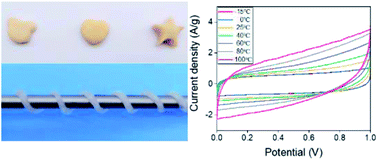All-solid-state supercapacitors using a highly-conductive neutral gum electrolyte†
Abstract
Recently, the development of safe, stable, and long-life supercapacitors has attracted considerable interest driven by the fast-growth of flexible wearable devices. Herein, we report an MnO2-based symmetric all-solid-state supercapacitor, using a neutral gum electrolyte that was prepared by embedding aqueous sodium sulfate solution in a biopolymer xanthan gum. Resulting from the high ion conductivity 1.12 S m−1, good water retention, and high structure adaption of such gum electrolyte, the presently described supercapacitor showed high electrochemical performance with a specific capacitance of 347 F g−1 at 1 A g−1 and an energy density of 24 μW h cm−2 The flexible supercapacitor possesses excellent reliability and achieves a retaining capacitance of 82% after 5000 cycles. In addition, the as-prepared supercapacitor demonstrated outstanding electrochemical stability at temperatures between −15 °C to 100 °C.



 Please wait while we load your content...
Please wait while we load your content...